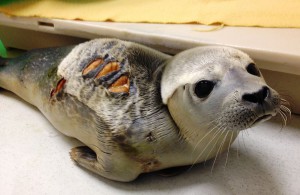Underwater Noise Pollution
Ship traffic along the Jersey Shore brings increased noise into the underwater environment for whales, dolphins and other marine animals. Unnatural noises interrupt communication, disrupting migration, communication, foraging, and reproduction patterns for many marine animals.
Underwater noise made by humans is increasing along the Jersey Shore and the south shore of Long Island. The change in sound levels in the environment has doubled every decade since the 1960s due to increased global shipping, economic activity, recreational boating, and energy exploration.
Yet for whales, dolphins, seals and other marine animals, their underwater environment is vital for communication. As their environment gets louder with man-made noises, communication for marine mammals often becomes masked or muted, like a conversation lost on a noisy city street.
Water is much denser than air, so molecules in the water are packed tighter together. This means that sound (which relies on molecules vibrating and pushing against one another) propagates much further and faster underwater than in air.
Since sound waves can travel unfaded for miles, the increased presence of loud or persistent sounds from ships, sonar devices, and oil rigs disrupts natural sounds in the marine environment and can disrupt normal whale and marine mammal behavior.
Many animals produce sound, from the tiny shrimp, to fish, including black drums, to dolphins and whales. There is good evidence to suggest that man-made noises along the coast or in the ocean can interfere with communication for aquatic animals and their way of life. Recent studies suggest that noise pollution can harm whales directly by damaging their hearing, and in extreme cases, causing internal bleeding and death. More commonly, it appears that excessive or prolonged noise can cause behavioral changes that interfere with the health and survival of the animals.
As the oil and natural gas industry lobbies for permission to drill offshore along the Jersey Shore, many scientists are saying that the deafening noise from seismic oil exploration could bring about devastating consequences. Extreme noise pollution has been known to kill hundreds of whales and dolphins at a time and diminish how marine animals find food and find a mating partner. At the very least these loud blasts can cause trauma to an animal. Underwater seismic air guns, which are probably the loudest noise that humans use regularly underwater and are used to survey for oil and gas, involve loud air guns blasted every 16 seconds, and at sounds greater than 180 decibels. By comparison, a person standing near a jet engine sounds like 140 decibels. But the noise is even worse underwater, where sound carries farther than it does through air. These seismic air guns are also now the most common method companies use to map the ocean floor.
More frequent along the Jersey Shore, though, are the persistent soft noises made by people, including from aquatic construction projects, such as the building of bridges, or from the movement of large ships and tankers, or from many recreational boats including jet skies. This noise may not kill animals directly, but can disrupt their ability to find food, locate reproductive mates or avoid predators or even restricting the ability for an animal to avoid a collision with a ship.
SEALS CAN BE INJURED BY NOISE TOO!
Unfortunately, frequently spotted around New York Harbor and the northern Jersey Shore are seals with bloody deep gashes or cuts on their body.
A harbor seal with a shark bite injury. Photo: University of New England Marine Animal Rehabilitation Center.
These wounds are probably not shark bites, even through some seals along the Jersey Shore are observed with injuries from shark attacks. Wounds from shark attacks on seals usually show lacerations where the teeth punctured the animal, almost like a stab wound. There would also be a half circle like pattern of punctures, consistent with the shape of a jaw of a shark.
Wounds on seals that are normally linear or straight often means an animal was struck by a spinning propeller on the back of a boat.
The poor seal in the above picture is most likely a victim of being hit by a duct propeller. Some wildlife scientists suspect that seals can get trapped or sucked between propellers and its covers. This is especially true for female harbor seals, because ducted blades produce the same or similar acoustics or sounds as the mating calls of male seals. Ducted propellers are widely used by large ships in North America.





